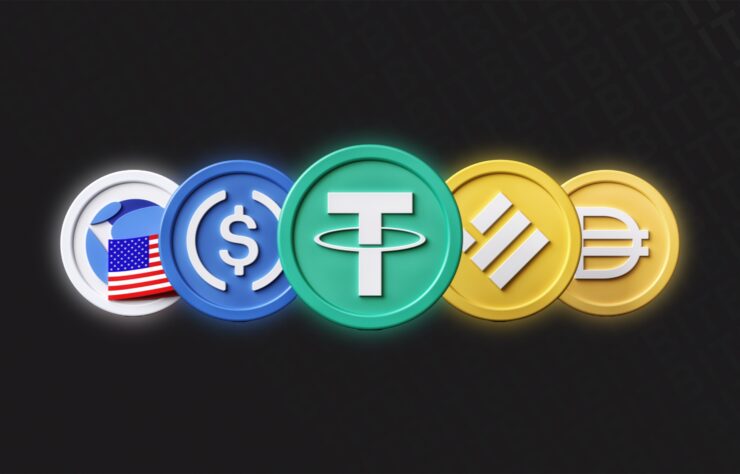Stablecoins are often considered a safer option in the volatile world of cryptocurrency. Their value is pegged to a stable asset like the US dollar, gold, or others, providing traders and investors with a reliable way to store value without exposure to high market fluctuations.
However, despite their name, stablecoins aren’t immune to losing their peg. When they do, it can lead to significant losses for investors and raise questions about their reliability. But why does this happen? Let’s explore the key reasons stablecoins lose their peg.
What Are Stablecoins and How Do They Work?
Before we discuss the reasons for losing their peg, it’s essential to understand what stablecoins are and what “losing their peg” means. Stablecoins are cryptocurrencies designed to maintain a fixed value relative to a stable asset. For example:
- Fiat currency reserves back fiat-backed stablecoins (e.g., USDT, USDC).
- Other cryptocurrencies secure crypto-backed stablecoins as collateral.
- Algorithmic stablecoins rely on supply-demand mechanisms and algorithms to maintain their price.
“Losing their peg” simply means the stablecoin’s value deviates significantly from the asset it’s tethered to, such as falling below $1 (in the case of USD-backed stablecoins).
Lack of Sufficient Reserves
One of the primary reasons stablecoins lose their peg is insufficient reserves. Fiat-backed stablecoins, like Tether (USDT) or USD Coin (USDC), are supposed to have reserves that fully or largely back the total supply of coins in circulation.
If the reserves are not sufficient to back all issued tokens, it creates market uncertainty. Any revelation of financial instability can lead to mass selloffs, causing the stablecoin to weaken or lose its peg.
Example
If a trader doubts whether there’s a real $1 backing every issued USDT token, they’ll quickly sell their holdings. The resulting panic snowballs as others sell too, creating downward pressure on the stablecoin price.
Market Panic and Confidence Issues
Market confidence is a critical element behind stablecoin stability. Even stablecoins fully backed by reserves can temporarily lose their peg during widespread panic.
News about regulatory crackdowns, liquidity issues, or market crashes can drive investors to sell off their holdings out of fear, reducing the stablecoin’s value.
Key takeaway
Stablecoins rely not only on reserves but also on trust. A breakdown in market confidence, even if unfounded, can destabilize the coin.
Algorithmic Failures
Algorithmic stablecoins don’t rely on reserves but on intricate algorithms and smart contracts to maintain their value. While innovative, this type of stablecoin is prone to losing its peg due to errors in the algorithm or unexpected spikes in market activity.
The infamous TerraUSD collapse in 2022 is a prime example of what can happen when an algorithmic stablecoin fails to keep its peg.
What happened with TerraUSD?
- TerraUSD (UST), pegged to $1, used an algorithmic mechanism tied to its sister token, Luna.
- When the market panicked and large numbers of tokens were sold off, the algorithm couldn’t manage the demand-supply balance, leading to a cascading de-pegging event.
Sudden Liquidity Shortages
Liquidity is crucial for stablecoins to maintain their peg. If a stablecoin doesn’t have enough liquidity for traders to engage in large transactions, its value may fluctuate.
For example, during times of high market volume, the lack of liquidity can create significant imbalances between supply and demand, causing stablecoins to lose their peg.
Regulatory Pressure
Governments and regulatory bodies worldwide are still figuring out how to handle stablecoins. Regulatory uncertainty often affects the stability of these assets. For instance:
- Banks might freeze the fiat reserves backing a stablecoin.
- Governments could crack down on the issuers due to compliance issues.
Such events often shake investors’ trust, leading to panic sell-offs and making it difficult for a stablecoin to maintain its peg.
Arbitrage and Market Forces
Arbitrage opportunities can also cause temporary peg fluctuations. For example:
- If a stablecoin’s value falls below $1, traders buy it up because they know they can sell it later at its correct value.
- Conversely, if its value rises above $1, traders sell high and cash in the profits.
While arbitrage generally works to restore the peg, extreme market volatility can magnify the issue and keep the stablecoin unstable for longer periods.
Over-reliance on Collateralized Debt
Crypto-backed stablecoins, like DAI, rely on other cryptocurrencies as collateral. This collateral can become a problem during highly volatile market conditions. For example:
- A rapid drop in the value of the collateral (e.g., Ethereum) can force liquidations.
- If liquidations happen too fast or at once, the stablecoin could lose its peg.
The reliance on volatile assets as collateral makes crypto-backed stablecoins inherently riskier during market downturns.
How Can Stablecoins Retain Their Peg?
While stablecoins are susceptible to losing their peg, issuers can implement measures to maintain stability:
- Transparent Audits: Regular and transparent audits reassure users about reserve sufficiency.
- Improved Liquidity: Ensuring sufficient reserves and access to liquidity buffers can help during market volatilities.
- Stronger Algorithms: Algorithmic stablecoins need continuous testing and upgrades to handle unexpected market conditions.
- Regulatory Compliance: Compliance with regulations can build stronger trust among users and reduce panic.
Conclusion
Stablecoins play a critical role in the cryptocurrency ecosystem by providing a way to store value and facilitate frictionless trading. However, they aren’t foolproof.
Factors such as insufficient reserves, market panic, algorithmic failures, and external attacks can cause them to lose their peg. While stablecoins have tremendous potential, understanding these risks is essential for investors and issuers alike.
By being aware of the vulnerabilities and relying on trusted issuers with clear safeguards, users can wisely manage their exposure to stablecoins.
If you want to stay updated on cryptocurrency trends or learn how to navigate stablecoin risks effectively, subscribe to our newsletter for expert insights!





